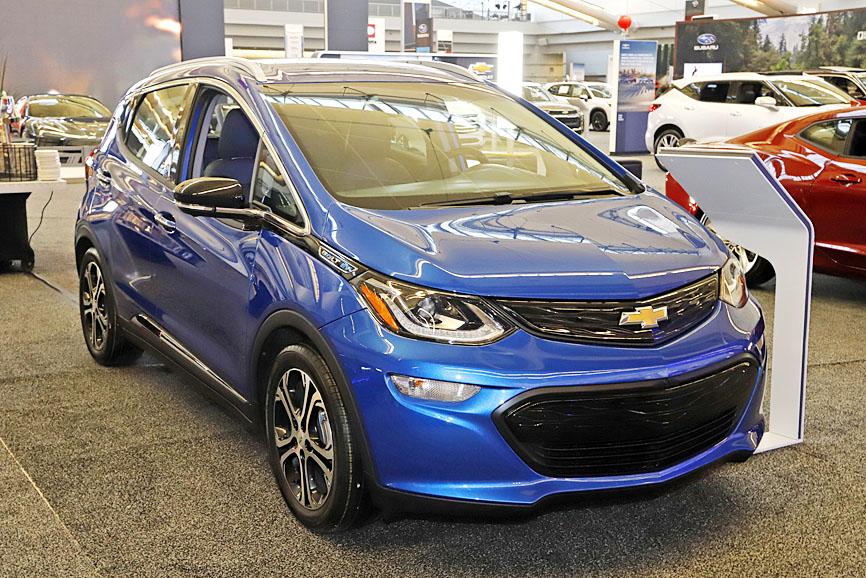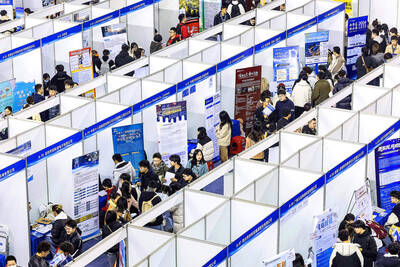General Motors Co (GM) is laying the groundwork for a bigger bet on electric vehicles (EV), telling investors at a virtual conference it plans to boost spending on them by more than a third to US$27 billion as part of a push to introduce 30 battery-powered models by 2025.
The initiative outlined on Thursday represents an increased investment of US$7 billion and 10 more EVs than previously planned, including some that would be cheaper than US$35,000.
The announcement comes as rival automakers plan dozens of new all-electric models, which could benefit from EV-friendly policy changes expected under the administration of US president-elect Joe Biden.

Photo: AP
BATTERY PRICE CUT
GM aims to cut the manufacturing cost of its Ultium battery pack by 60 percent, enabling EVs to achieve near price parity with gasoline-powered cars by around the middle of the decade, GM executive vice president of global product development Doug Parks said at a Barclays auto conference.
The automaker, which has struggled to sell its all-electric Chevrolet Bolt, said its next generation of EVs would appeal to a wider variety of buyers now that Tesla Inc has primed the market for sexier and sportier battery-powered vehicles.
“We don’t want to just participate, we want to lead,” Parks said in a conference call on Thursday with reporters. “Tesla has a good jump. They’re a formidable competitor and there are a lot of startups. We don’t want to cede leadership.”
GM must also keep pace with traditional competitors. Volkswagen AG last week said that it plans to spend about US$86 billion on new technology, with most of it going to electric vehicles.
With its new investment, GM expects to bring some planned vehicles to market faster.
The Cadillac Lyriq crossover SUV is to arrive in early 2022, instead of late that year. The Hummer EV is also to arrive faster than its planned date next fall, but the company did not specify exactly how much earlier.
GM is expediting development of three GMC models (including an EV pickup), four Chevrolet models (including a pickup and compact crossover), four Cadillacs and two Buicks.
Parks would not disclose the timing for the launch of these vehicles.
The electric-pickup market is heating up, with a battery-powered Ford F-150 and Tesla’s Texas-built Cybertruck on the way, as well as competition from start-ups, such as Amazon.com Inc-backed Rivian Automotive Inc.
Parks said the Chevy crossover SUV would be about the size of the current Equinox compact and cost less than US$35,000. That would make it cheaper than the average gasoline-powered vehicle sold today.
NEW FACILITY
GM is already preparing to launch a second generation of the Ultium battery pack co-developed with LG Chem Ltd. that has increased power density.
As a result, GM anticipates a driving range as far as 450 miles (724km) on a single charge.
The automaker plans to break ground next year on a new facility to develop the battery chemistry for the next-generation Ultium, which a spokeswoman said might be located on the grounds of GM’s global technical center in Warren, Michigan, outside Detroit.

Taiwan Transport and Storage Corp (TTS, 台灣通運倉儲) yesterday unveiled its first electric tractor unit — manufactured by Volvo Trucks — in a ceremony in Taipei, and said the unit would soon be used to transport cement produced by Taiwan Cement Corp (TCC, 台灣水泥). Both TTS and TCC belong to TCC International Holdings Ltd (台泥國際集團). With the electric tractor unit, the Taipei-based cement firm would become the first in Taiwan to use electric vehicles to transport construction materials. TTS chairman Koo Kung-yi (辜公怡), Volvo Trucks vice president of sales and marketing Johan Selven, TCC president Roman Cheng (程耀輝) and Taikoo Motors Group

Stephen Garrett, a 27-year-old graduate student, always thought he would study in China, but first the country’s restrictive COVID-19 policies made it nearly impossible and now he has other concerns. The cost is one deterrent, but Garrett is more worried about restrictions on academic freedom and the personal risk of being stranded in China. He is not alone. Only about 700 American students are studying at Chinese universities, down from a peak of nearly 25,000 a decade ago, while there are nearly 300,000 Chinese students at US schools. Some young Americans are discouraged from investing their time in China by what they see

MAJOR DROP: CEO Tim Cook, who is visiting Hanoi, pledged the firm was committed to Vietnam after its smartphone shipments declined 9.6% annually in the first quarter Apple Inc yesterday said it would increase spending on suppliers in Vietnam, a key production hub, as CEO Tim Cook arrived in the country for a two-day visit. The iPhone maker announced the news in a statement on its Web site, but gave no details of how much it would spend or where the money would go. Cook is expected to meet programmers, content creators and students during his visit, online newspaper VnExpress reported. The visit comes as US President Joe Biden’s administration seeks to ramp up Vietnam’s role in the global tech supply chain to reduce the US’ dependence on China. Images on

New apartments in Taiwan’s major cities are getting smaller, while old apartments are increasingly occupied by older people, many of whom live alone, government data showed. The phenomenon has to do with sharpening unaffordable property prices and an aging population, property brokers said. Apartments with one bedroom that are two years old or older have gained a noticeable presence in the nation’s six special municipalities as well as Hsinchu county and city in the past five years, Evertrust Rehouse Co (永慶房產集團) found, citing data from the government’s real-price transaction platform. In Taipei, apartments with one bedroom accounted for 19 percent of deals last